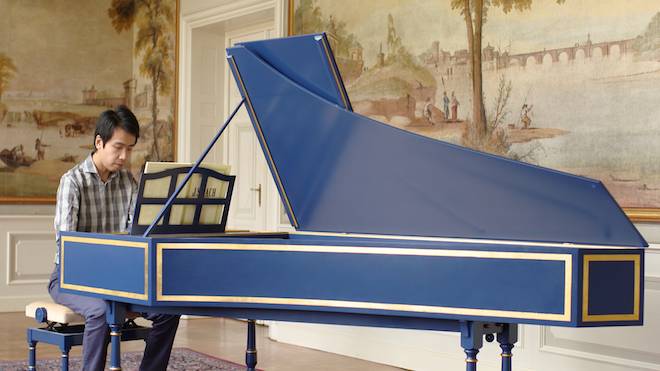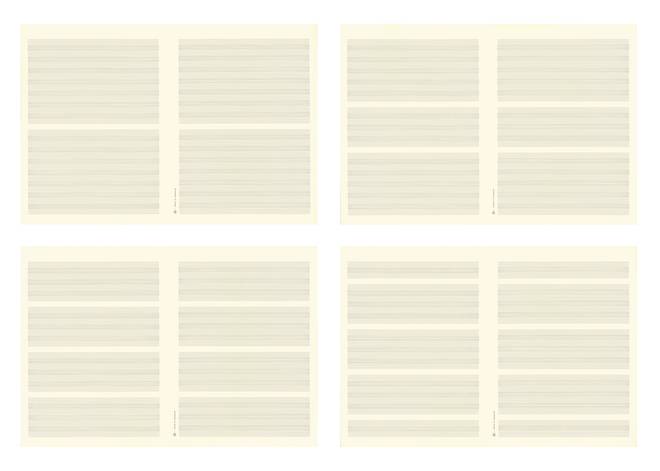本文仅限英文阅读
Ang Song-Ming “Logical Progressions”
FOST Gallery (1 Lock Road, #01-02, Gillman Barracks, Singapore 108932) Jan 10-Mar 02, 2014
A tall, long-limbed man sits at a harpsichord in an opulent Baroque reception room. He begins playing, he plays J.S.Bach’s C Major Prelude to The Well-Tempered Clavier (Book 1). A classical Classical piece. The man is depicted in two videos—one close up, one not—that track around player and harpsichord in tandem. The piece finishes—pause—playing recommences, the sound now strange but also somehow familiar: the C Major Prelude in reverse. For this film, Ang Song-Ming learned to play the harpsichord.
Ang Song-Ming, tall and lanky, has an easy bearing, with a wry, sometimes incredulous humor that belies the precision and dedication of his work. Having studied literature at the National University of Singapore, Ang obtained a masters in Aural and Visual Cultures at Goldsmiths College, London. He now lives in Berlin, where I met him at his home one chilly day in December and again this week at Art Stage Singapore.
“Backwards Bach” (2-channel video, 5:12, 2013) is a fine example of Ang’s approach to art, combining deliberate personal dedication, concentration and effort with very precise expression—reverse Bach!—and a temporal shift of context, both alienating and beguiling. The latter makes all concerned concentrate more, whether Ang himself, his participants or viewers. Another example on display at Art Stage Singapore courtesy of Singapore Tyler Print Institute is “Be True to your School” (2010), a single-channel video in which Japanese people are asked to sing their old school song, combines music, awkward embarrassment, confusion and of course Proustian temporal shifts by asking someone to travel back in time to their school days (and to an instrument of instruction to engender infant loyalty to a pastoral and pedagogic institution).
In “Music Manuscripts” (2013), a set of black-line drawings made with architectural felt-tip pens, Ang tasked himself, somewhat obsessively, with exploring the umpteen possibilities for expanding the lines of the standard 5-line stave on standard music manuscript paper, used for handwriting musical scores. He only accepts perfectly completed drawings—the least blemish disqualifies the work. The “music” lies in their production—the regularity and interruptions in the lines, in the absence of notes. In fact, it is note-less note paper—but ruled not blank: the ruled lines echoing the “rules” Ang set for their production. Or put another way, in the absence of musical notes remains the rules. It would be risky to over-interpret that but nonetheless it is a theme. Another is the tension between “scoring,” both cutting and winning, and “drawing a line”—literally pulling out a “line,” from a pen or pencil, or a fishing line or even boat tether—in the sense of linguistics, logic, time and space, and also linguistically in terms of setting a limitation. Present in every drawing is the conflict between the infinitive “drawing”—the endless line—and an established rule, a consequential barrier, a line drawn (scored) in the sand-paper.
“Be True to your School” was made during Song-Ming’s residency at ARCUS Project in Japan. Another work from this period is “Color Scale” (2010), seven color photographs of houses echoes a rainbow-colored child’s Xylophone. And apparently here is the xylophone too. But no—the echo has been inverted: the keyboard spray-painted to match the colors of the houses. It reveals how sometimes synaesthesia and recollection are reverse-engineered, not a figment of our imagination but something constructed for our imagination: content designed for reflection. It is sweet nostalgia spiked with sugar, salt and msg—manufactured to meet our desire to confirm, to make us say yes! And this is the charm of Song-Ming’s work. It plays on and to seemingly simple ideas of what we (think we) already like and know. We think we know about the “Well tempered klavier,” our old school song, even the score lines on manuscript paper. But this was all pre-programed. And yet, while the rules remain the rules, when set askew we seem them better.
Biography
Song-Ming Ang (b. 1980) studied at the National University of Singapore and Goldsmiths College London. He has presented solo shows with Spring Workshop (Hong Kong), FuturePerfect (Singapore), SoundFjord (London); and exhibited at Künstlerhaus Bethanien (Berlin), Haus der Kulturen der Welt (Berlin), Armory Art Show (New York), Art Basel (Miami Beach), and the 3rd Singapore Biennale. Ang is the 2011 recipient of the Young Artist Award, conferred by the National Arts Council of Singapore. Ang lives and works between Berlin and Singapore.








